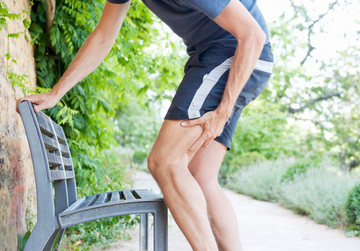Hamstring injuries are common, especially for athletes and active individuals. Depending on the severity of the injury, symptoms can range from discomfort to being completely debilitating and should be treated immediately. Left untreated, improper hamstring injury recovery may lead to a higher chance of subsequent injuries as well as painful ailments like arthritis in the knee joint.
We’re taking a look at how to treat a hamstring injury to get you back on your feet in as little time as possible. We’ll look at what these injuries are, common symptoms you may experience, as well as possible treatment options to minimize hamstring injury recovery time. As always, consult your doctor before beginning any form of treatment or health routine.
What Are Hamstring Injuries?
Before we can dive into how to treat a hamstring injury, what are they? The hamstrings are a series of three skeletal muscles located on the back of your thighs, and are essential to helping us stand, walk, move, climb stairs, or perform any form of leg movement.
Hamstring injuries are a pulling, tearing, or excessive strain on these muscles. While particularly common for athletes who run, lunge, or jump as part of their sport, anyone can experience hamstring injuries. Tight muscles, improper stretching, or incorrect leg movements can all culminate in the immediate need for hamstring injury recovery.
Hamstring injuries are categorized into three groups:
- Grade 1: Mild muscle strain or pull
- Grade 2: Partial muscle tear of one or more hamstring muscles
- Grade 3: Complete tear of hamstring muscle
Grade 1 Hamstring Muscle Injuries
This level of hamstring injury is characterized as a mild muscle strain or pull. These are the least severe and tend to have the fastest recovery period. The hamstring injury recovery time for Grade 1 typically ranges from a few days to a week or two.
Grade 2 Hamstring Injuries
The second level of severity when it comes to hamstring injuries is listed as a partial tear of one or more of the hamstring muscles. These injuries are more painful and may require a little longer to heal. Grade 2 hamstring injury recovery time may take upwards of 3 to 8 weeks.
Grade 3 Hamstring Injuries
The most severe hamstring injuries involve a complete muscle tear. People experiencing a Grade 3 hamstring injury will have the longest recovery time. This level may require crutches or other aids during hamstring injury recovery. The recovery period for Grade 3 hamstring injuries could take up to 3 months or more.
Symptoms of Hamstring Injuries
Recognizing the symptoms of a hamstring injury is crucial to knowing how severe it may be, as well as letting you know to seek treatment right away.
Grade 1: Grade 1 hamstring injury symptoms are most often characterized by sudden pain radiating from your thigh. It may not be difficult to walk or move your leg, but your overall strength is likely left unaffected. While the temptation to “work it out” may come to mind for Grade 1 discomforts, continued overuse could do more damage to your body and be counterproductive to hamstring injury recovery.
Grade 2: This category of hamstring injuries is more painful than Grade 1 and is commonly accompanied by swelling or bruising. At this stage, there may be some strength loss in your leg, as well, making it a little more difficult to walk or get around without assistance.
Grade 3: The third category of hamstring injuries has the most severe symptoms. This complete muscle tear produces intensified pain, tenderness, swelling, and more. Some people who experience a Grade 3 hamstring injury report hearing a popping sound when the injury occurs. These symptoms will most likely have the longest hamstring injury recovery time and may require different complementary therapy types to fully heal properly.
How to Manage Hamstring Injury Recovery
To expedite your hamstring injury recovery time, it’s crucial to seek medical advice and start treatment right away. Some of the most common methods for how to treat a hamstring injury include:
- Following the R.I.C.E. method
- Getting a massage
- Stretching gently
- Applying cold therapy with specific movement exercises
Following the R.I.C.E. Method
The R.I.C.E. method is one of the most common sports injury recovery techniques but is also beneficial for anyone who needs hamstring injury recovery. The acronym stands for:
- Rest
- Ice
- Compression
- Elevate
The first part of this hamstring injury recovery method is to rest your injured leg for 24-48 hours after the incident occurred. This prevents further injury from happening and starts the healing process. During this period, you should also ice the injured area for 15-20 minutes at a time, two to three times a day. Be sure to never apply ice packs directly to the skin or you may damage the surface tissue. Instead, wrap your ice pack and hold it against your body that way.
Sometimes you may experience swelling during hamstring injury recovery. This is a common symptom and is managed with the next step in the R.I.C.E. method: compression. Any kind of elastic medical bandage can be used as a compression wrap. You may also consider an elastic thigh sleeve to keep it from moving or coming unraveled.
Lastly, you should elevate the injured leg above the heart level. This is meant to reduce pain levels, alleviate swelling, and help expedite your hamstring injury recovery time. Not all forms of elevation are equal, however. If you’re simply elevating your legs while lying on the couch, be sure you’re not accidentally adding excess pressure on the damaged hamstring muscles. Many people have turned to the benefits of massage chairs with zero gravity position capabilities to elevate their legs and pair the R.I.C.E. method with other hamstring injury recovery treatments.
Getting a Massage
Speaking of massage, this is another potentially beneficial treatment method to help with hamstring injury recovery. Sports massage or any form of soft tissue therapeutic massage technique serves to stimulate blood circulation and help the muscles heal more quickly. Massage alleviates pain while keeping muscle groups loose and flexible. This means it also works to protect your range of motion, which is especially important for athletes during hamstring injury recovery.
If you’re experiencing a hamstring injury, making and getting to a massage therapy appointment may not be an easy task. Instead, many people are turning to the benefits of owning a massage chair at home for hamstring injury recovery as well as part of their overall wellness routine. SL-track massage chairs (sometimes referred to as L-track massage chairs) have rollers that work from the neck all the way to the top of the hamstrings. This makes them especially helpful for hamstring injury recovery while deepening your relaxation.
Luxury massage chairs may also have zero gravity reclining capabilities on their list of features. This allows the user to combine the elevation part of the R.I.C.E. method with the therapeutic qualities of massage to minimize hamstring injury recovery time and get you back on your feet. Other massage chair features like heat therapy may also serve your recovery period well, helping alleviate pain and swelling while stimulating blood flow for faster healing.
Massage chairs offer many different types of massage at the touch of a button, making them an efficient tool for hamstring injury recovery. There are even AI massage chairs that use two types of body scanning to determine your body’s needs and treat them. This is ideal for those who may not be sure of the right type of massage for hamstring injuries or are unaware of different features to combine for maximum recovery.
Bonus Tip: Don’t wait until you’re injured to experience the benefits of a massage chair. They’re one of the most popular recovery tools for athletes of all levels.
Stretching Gently
Another method for hamstring injury recovery is doing simple stretches to keep the muscles loose as they heal. These stretches are intended to protect and revitalize range of motion so your healing process is complete.
A couple of simple stretches to help with hamstring injury recovery are standing hamstring stretches and wall hamstring stretches.
Standing Hamstring Stretch
This simple stretch should be done gently and with respect to any limits you may have while injured. The steps for this stretch are:
- Place the heel of your injured leg on a low chair or stool.
- Keep your leg extended as straight as possible and lean forward until you feel it stretch.
- Hold this pose for 15 to 30 seconds.
- Repeat the stretch three to four times without pushing it too far.
Wall Hamstring Stretch
The wall hamstring stretch can be done in any doorway and from the comfort of home. Like the standing stretch, be sure to mind your movement limitations while following these steps:
- Lie on your back near the edge of a doorframe.
- Raise your injured leg and rest your heel against the frame.
- Gently straighten your leg as far as you can.
- Hold this pose for 30 to 45 seconds.
- Repeat this stretch 3 times from the start.
Applying Cold Therapy With Movement Exercises
Cold therapy application is part of the R.I.C.E. method, but has other exercises you can pair with it to facilitate faster hamstring injury recovery. The cold from the ice pack helps reduce swelling and alleviate pain. While applying an ice pack, sit on a table with your injured leg hanging off and dangling. Very gently, raise your leg up and lower it back down as you ice the injured area to keep the muscles loose. This exercise will help maintain your range of motion as you heal.
After you’re finished icing your hamstring area, you can continue this movement exercise by lying flat on your stomach and slowly bending and straightening your leg to work out the muscles.
Hamstrings injuries are common but most people can expect a full recovery with the proper immediate treatment. Consult your doctor to discuss the best method for your hamstring injury recovery and consider different techniques like the R.I.C.E. method and using a massage chair. The application of various healing measures will have you back on your feet in no time.
The uses of a massage chair go beyond hamstring injury recovery. Learn more about the benefits of massage and see how massage chairs can positively impact your lifestyle.





